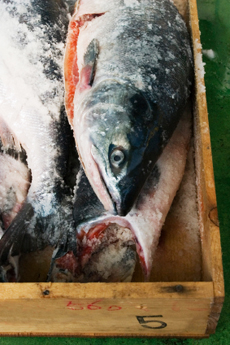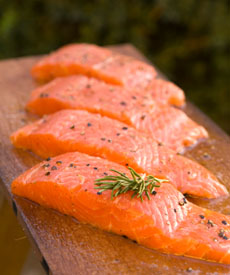 A wild, line-caught salmon. Photo by Stuart Pitkin | IST. A wild, line-caught salmon. Photo by Stuart Pitkin | IST.
September 2011
|
 |
Wild Salmon Vs. Farmed Salmon
Facts, Problems, Benefits
Overview
Americans love salmon. We’ve been told it’s good for us: fully of omega-3 fatty acids and the best kind—fish omega 3s are stronger than vegetable or pills. Omega -3s prevent heart disease, lower the triglycerides that cause high cholesterol, prevent certain cancers and regulate insulin levels.
Much of what is available today in supermarkets is farmed salmon—it’s far more affordable than wild-caught salmon. Yet, we hear recurring alerts about farmed salmon.
Between 80% and 90% of the salmon in the U.S. is farmed. United States, the number is higher – 90% by some estimates.) Thirty percent come from traditional hatcheries, and the remaining 50% are raised in aquaculture or “open pen nets” just off shore. Farms can “raise” up to a million salmon at a time.
What’s the difference? Is farmed salmon bad for you? What’s the scoop on wild salmon versus farmed salmon?
Wild salmon is better. A 2005 study showed that the net benefits of eating wild Pacific salmon outweigh those of eating farmed Atlantic salmon, when the risks of chemical contaminants are considered, and concluded that wild salmon is the preferred choice. In addition, farmed fish can have a negative impact on the environment.
Salmon is farmed in crowded pens, where they are fed food pellets and antibiotics to help limit the spread of disease (which happens in a closed-in environment). Dioxin,(1) polychlorinated biphenyls (PCBs) and other toxins are found in the fish.
However, not all farmed salmon is created equally bad. Significant differences in farmed salmon contaminants were found by region, with Canadian and Chilean salmon showing the lowest levels and European farmed salmon (particularly from Scotland) showing the highest levels.
|
|

A salmon farm. Farmed fish escape from their pens, compromising the wild salmon supply. Photo by Ollrig | IST. |
(1) According to the World Health Organization, dioxins are highly toxic and can cause reproductive and developmental problems, damage the immune system, interfere with hormones and also cause cancer. They accumulate in the fatty tissue of animals. Learn more.
(2) According to the EPA, PCBs, which were banned in 1979, do not readily break down and thus may remain for long periods of time in the air, water and soil. They can accumulate in the leaves and above-ground parts of plants and food crops. They are also taken up into the bodies of small organisms and fish. As a result, people who ingest fish may be exposed to PCBs that have bioaccumulated in the fish they are ingesting. Learn more.
Here are the pros and cons:
Wild Salmon
Pro:
- Wild salmon are 30% leaner than farmed salmon, with 20% more protein.
- Wild salmon contain far fewer toxins. In January 2004, the journal Science warned that farmed salmon contain 10 times more toxins (dioxin, PCBs, etc.) than wild salmon. The study recommended that farmed salmon be eaten only once every month or two.
- Wild salmon have no negative environmental impact.
Con:
- Wild salmon is much more expensive.
Farmed Salmon
Pro:
- Farmed salmon is more affordable, and available year-round (wild salmon has limited availability during the fall spawning season).
- Farmed salmon have higher levels of omega-3 fatty acids, due to the fish oil added to their feed.
Con:
- However, the risks from the toxins far outweigh the benefit of the fatty acids.
- Farmed salmon tends to have much higher levels of chemical contaminants that are known to cause cancer, memory impairment and neurobehavioral changes in children.
|
|

Wild vs. farmed salmon: The choice is yours. Photo by Funwithfood | IST. |
- Farmed salmon have a reliable food source and less ability which to swim, so they don’t get as much “exercise” as wild salmon. Thus, bodies are fattier than wild salmon.
- The antibiotics and other chemicals (including pesticides) used to treat farmed fish have been known to leak into the water supply, affecting other marine life in addition to salmon.
- Antibiotic resistance in humans has been attributed to the increased exposure to antibiotic chemicals in food and water supplies, of which fish farms are a significant contributor.
- Farmed salmon escape from their river pens, where they spread diseases and parasites to wild salmon. Escaped farmed salmon breed with wild salmon, diluting the gene pool and the wild salmon’s ability to survive.
- One study showed that sea lice from salmon farms kill up to 95% of juvenile wild salmon that migrate past them.
What About Organic Salmon?
There is no industry or federal standard for organic fish farming. Organic implies that no antibiotics are put into the water, but the feed and the living conditions still bring contaminants.
It may seem as if we’ve tipped the scales in favor of wild salmon. But if you can point us to pro-farmed salmon, we’re happy to add the information. Use the Contact Us form on this page.
References
© Copyright 2005-
Lifestyle Direct, Inc. All rights reserved. Images are the copyright of their respective owners.

|

 A wild, line-caught salmon. Photo by Stuart Pitkin | IST.
A wild, line-caught salmon. Photo by Stuart Pitkin | IST. 
